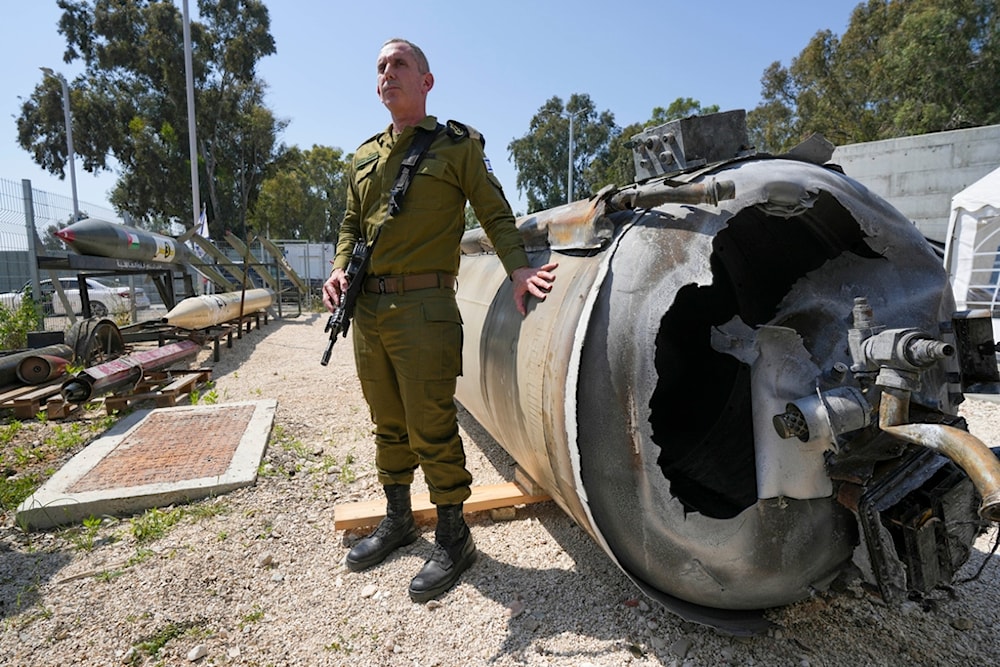Israeli media debunk IOF claims about damage from Iran's strike
A researcher specializing in "Israel's" wars reveals new details concealed by the Israeli occupation army about the impact of the Iranian retaliatory strikes.
-

Israeli military spokesperson Daniel Hagari displays to the media one of the Iranian ballistic missiles reportedly intercepted over the weekend, southern occupied Palestine, Tuesday, April 16, 2024. (AP Photo)
Ori Vialkov, a researcher specializing in "Israel's" wars, revealed Wednesday that the Israeli occupation military underreported details regarding Iran's latest retaliatory attacks against Israeli targets in occupied Palestine.
Vialkov told the Israeli newspaper Maariv that Iran's Operation True Promise witnessed the launch of approximately 185 "Shahed 136" drones and their jet-powered version, the "Shahed 238", which can reach a speed of up to 500 kilometers per hour.
The researcher said that the Iranian forces launched dozens of cruise missiles and around 110 ballistic missiles, noting that the US military intercepted at least six missiles using American destroyers equipped with the Aegis missile defense system.
He highlighted that Iran fired several long-range ballistic missiles toward "Israel" from various launch sites on Iranian soil but did not use all types of its missiles during this operation.
According to Vialkov, Iran possesses around 3,000 ballistic missiles, and about 800 to 1,000 have a range that can reach occupied lands.
Some of the missiles used by Iran during its retaliatory strikes against "Israel" include:
- "Kheibar," which entered service in 2022 with a range of 1450 km and a warhead of 500 kg;
- "Emad," which entered service in 2016 with a range of approximately 2,500 km and a warhead of 750 kg;
- "Ghadr-110," an enhanced version of the "Shahab 3" with a range between 1,800-2,000 km and a warhead ranging from 650 kg to 1,000 kg;
- and possibly the "Shahab 3B" with a range of 2,000 km and a warhead of 700 kg.
The researcher pointed out that the Iranians did not use more advanced missiles such as the "Sejil," with a range of 2,500 km and a warhead of 1,500 kg, or the "Khorramshahr," a missile with a range of 2,000 km and a warhead of 1,800 kg, and its upgraded version, the "Khorramshahr 4," which they may have reserved for future operations.
The I-R-G-C launched a monumental operation late Saturday, targeting the Israeli occupation with dozens of missiles and drones in retaliation to "Israel's" attack on Iran's consulate in #Damascus two weeks ago.
— Al Mayadeen English (@MayadeenEnglish) April 14, 2024
The codenamed "Truthful Promise" operation that targeted "Israel"… pic.twitter.com/TyW2QAA92g
Damage caused by the Iranian retaliation
The Iranian forces attacked three main bases: the "Hermon" base, the "Nevatim" base, and the "Ramon" base, Vialkov mentioned, citing a map published by an Iranian-run website.
However, the Israeli occupation military claims that only the "Nevatim" Airbase suffered minor damage and the "Hermon" base had a road damaged in its vicinity, while the "Ramon" base was not hit at all.
1- 'Nevatim'
The researcher recalled that Israeli sources told ABC News that five Iranian missiles hit "Nevatim", damaging a C-130 transport plane, a non-active runway, and an empty storage building.
According to the report, the Israeli anti-air systems intercepted nine missiles, not seven as claimed by Daniel Hagari, the spokesperson for the Israeli occupation army.
Hagari said that only four or five missiles hit the "Nevatim" base, causing minor damage to a C-130 transport plane hit by missile fragments.
But video analysis shows at least four Iranian missile impacts, not interception missiles, at the base. The Iranian forces also confirmed that they achieved three precise hits at the "Nevatim" base; hitting one runway, damaging one building, and hitting another building and the hangars. In addition, expert analysis shows five hits.
2- 'Hermon'
Vialkov revealed that an analysis of the image published by Hagari shows that an Iranian drone managed to penetrate the "Hermon" area and hit a road there, refuting the Israeli spokesperson's claims that a missile or interception fragments landed on the road and that no drones breached the occupied airspace.
3- 'Ramon'
After analyzing satellite images of the "Ramon" base, analysts claim that Iran failed to hit aircraft hangars, ammunition buildings, or command and control centers, the Israeli researcher mentioned, but noted that other analyses suggested that the base may have been targeted with five hits on several of its warehouses, maintenance facilities, and vicinity.
4- 'Dimona' Nuclear Reactor
Elsewhere, Vialkov told Maariv that satellite image analysis revealed there was at least one hit on one of the buildings in the "Dimona" Nuclear Reactor and up to two hits in its vicinity as a result of the Iranian strike. He noted that these analyses are based on low-quality satellite images, and only with the availability of high-quality satellite images can the true damage inflicted on the base be determined.
In conclusion, Vialkov suggested that the interception rate of the Iranian missiles was approximately 84%, still a very high percentage, but incomparable to the Israeli occupation army's 99%, which gave a sense that all Iranian threats were intercepted.
Read more: Iron Dome failed to intercept all seven hypersonic missiles: Press TV

 5 Min Read
5 Min Read










